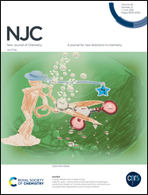Nitrogen-doped multi-channel carbon nanofibers incorporated with nickel nanoparticles as a multifunctional modification layer of the separator for ultra stable Li–S batteries†
Abstract
Lithium–sulfur batteries are regarded as the most promising electrochemical energy storage device as a result of their satisfactory high specific capacity and high energy density values. However, the inferior conversion efficiency of lithium polysulfides (LiPSs) in essence leads to fast capacity decay, especially at a large current density during the charge–discharge process. Herein, we have successfully demonstrated that the conversion efficiency of LiPSs was remarkably promoted by employing nickel nanoparticles incorporated with nitrogen-doped multi-channel carbon nanofibers (Ni-NMCCF) as a multifunctional modification layer of the separator. The high polarity of the nitrogen atoms and the Lewis acid characteristics of the nickel atoms collectively create strong anchoring activity towards LiPSs, therefore leading to the severe inhibition of the occurrence of the shuttle effect. The electrocatalytic activity of the nickel nanoparticles greatly accelerates the reversible conversion efficiency of LiPSs, ensuring high capacity retention during long-term cycling. Thanks to these advantages, Ni-NMCCF delivered a superb rate performance of 1020 mA h g−1 at 1C and maintained 671 mA h g−1 even after 500 cycles, which is equivalent to a capacity decay of only 0.07% per cycle.



 Please wait while we load your content...
Please wait while we load your content...